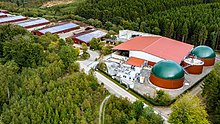
| Part of a series on |
| Sustainable energy |
|---|
 |
Anaerobic digestion is a sequence of processes by which microorganisms break down biodegradable material in the absence of oxygen.[1] The process is used for industrial or domestic purposes to manage waste or to produce fuels. Much of the fermentation used industrially to produce food and drink products, as well as home fermentation, uses anaerobic digestion.
Anaerobic digestion occurs naturally in some soils and in lake and oceanic basin sediments, where it is usually referred to as "anaerobic activity".[2][3] This is the source of marsh gas methane as discovered by Alessandro Volta in 1776.[4][5]
Anaerobic digestion comprises four stages:
The digestion process begins with bacterial hydrolysis of the input materials. Insoluble organic polymers, such as carbohydrates, are broken down to soluble derivatives that become available for other bacteria. Acidogenic bacteria then convert the sugars and amino acids into carbon dioxide, hydrogen, ammonia, and organic acids. In acetogenesis, bacteria convert these resulting organic acids into acetic acid, along with additional ammonia, hydrogen, and carbon dioxide amongst other compounds. Finally, methanogens convert these products to methane and carbon dioxide.[6] The methanogenic archaea populations play an indispensable role in anaerobic wastewater treatments.[7]
Anaerobic digestion is used as part of the process to treat biodegradable waste and sewage sludge. As part of an integrated waste management system, anaerobic digestion reduces the emission of landfill gas into the atmosphere. Anaerobic digesters can also be fed with purpose-grown energy crops, such as maize.[8]
Anaerobic digestion is widely used as a source of renewable energy. The process produces a biogas, consisting of methane, carbon dioxide, and traces of other 'contaminant' gases.[1] This biogas can be used directly as fuel, in combined heat and power gas engines[9] or upgraded to natural gas-quality biomethane. The nutrient-rich digestate also produced can be used as fertilizer.
With the re-use of waste as a resource and new technological approaches that have lowered capital costs, anaerobic digestion has in recent years received increased attention among governments in a number of countries, among these the United Kingdom (2011),[10] Germany,[citation needed] Denmark (2011),[11] and the United States.[12]
- ^ a b "Anaerobic Digestion". NNFCC Renewable Fuels and Energy Factsheet. National Non-Food Crops Centre. Retrieved 22 November 2011.
- ^ Koyama, Tadashiro (1963). "Gaseous metabolism in lake sediments and paddy soils and the production of atmospheric methane and hydrogen". Journal of Geophysical Research. 68 (13): 3971–3973. Bibcode:1963JGR....68.3971K. doi:10.1029/JZ068i013p03971.
- ^ Pamatmat, Mario Macalalag; Bhagwat, Ashok M. (1973). "Anaerobic metabolism in Lake Washington sediments" (PDF). Limnology and Oceanography. 18 (4): 611–627. Bibcode:1973LimOc..18..611P. doi:10.4319/lo.1973.18.4.0611. Archived from the original (PDF) on 16 December 2013.
- ^ Zehnder, Alexander J. B. (1978). "Ecology of methane formation". In Mitchell, Ralph (ed.). Water Pollution Microbiology. Vol. 2. New York: Wiley. pp. 349–376. ISBN 978-0-471-01902-2.
- ^ MacGregor, A. N.; Keeney, D.R. (1973). "Methane formation by lake sediments during in vitro incubations". Journal of the American Water Resources Association. 9 (6): 1153–1158. Bibcode:1973JAWRA...9.1153M. doi:10.1111/j.1752-1688.1973.tb05854.x.
- ^ "Anaerobic digestion reference sheet" (PDF). waste.nl. Archived from the original (PDF) on 5 October 2011. Retrieved 25 October 2007.
- ^ Tabatabaei, Meisam (2010). "Importance of the methanogenic archaea populations in anaerobic wastewater treatments" (PDF). Process Biochemistry. 45 (8): 1214–1225. doi:10.1016/j.procbio.2010.05.017.
- ^ "Agricultural Biogas". clarke-energy.com. Retrieved 8 November 2011.
- ^ "Jenbacher Gas Engines". clarke-energy.com.
- ^ "Anaerobic Digestion Strategy and Action Plan" (PDF). defra.gov.uk. Retrieved 19 January 2012.
- ^ "Jyllands-Posten". 29 December 2011. Retrieved 19 January 2012 – via Google Translate.
- ^ "AgSTAR Data and Trends". United States Environmental Protection Agency. 3 July 2019. Retrieved 18 October 2019.